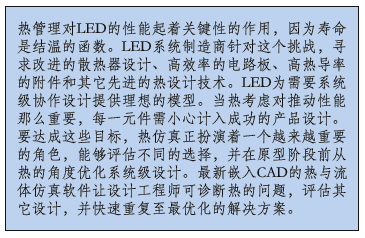
Thermal management is critical to overall system performance so mechanical designers need to consider thermal issues from the earliest stages of the design.
The United States Department of Energy (DoE) heralds LED lighting technology because it offers significant energy saving opportunities while enhancing the quality of the building environment. Thermal management is critical to LED performance because the useful service life of the LED is a function of junction temperature. LED system manufacturers are addressing this challenge by seeking out improved heatsink designs, high efficiency circuit boards, high thermal conductivity enclosures and other advanced thermal design techniques. The LED offers an ideal model of the need for system level co-design. When thermal considerations are so overwhelming a performance driver, every component needs to be carefully factored into a successful product design. To meet these objectives, thermal simulation is playing an increasingly important role because of its capability to evaluate alternatives and optimize the system-level design from a thermal standpoint prior to the prototype phase.
Emergence of LED Lighting
Solid-state lighting is a pivotal emerging technology that promises to fundamentally alter lighting options in the future. LEDs were originally designed to operate with less than 50 milliwatts of electric power. Over the last decade, LED power consumption has decreased dramatically, to 40 to 80 lm/watt. Besides energy efficiency, LEDs also offer longer life, and depending on the manufacturer and type, the useful life for white LEDs can range from approximately 6,000 hours to more than 50,000 hours. This compares to 30,000 hours for fluorescent tubes and less than 2,000 hours for incandescent bulbs. LEDs can also be manufactured to emit light of a specific color without the use of filters.
Market analysis firm Yole Développement says that high power LEDs will drive growth in the solid state lighting market, starting at well under $1 billion in revenue in 2007 to approximately $10.3 billion in 2012. Yole projects that high-brightness and ultrahigh-brightness LEDs sales will be responsible for about $4.45 billion of that total, over 5.5 times the $783 million market size in 2007. “These solid state lighting devices are rapidly becoming the lighting source of choice for diverse applications that include traffic signals, interior and exterior lighting in cars and trucks, large screen visual displays, and small LCD backlighting and decorative illumination,” a recent iSuppli report states1. “And new lighting applications are constantly being discovered.”
Thermal Challenges
High-powered LEDs provide greater thermal challenges than most other light sources, largely because LEDs don’t generate infrared radiation. According to the U.S. Department of Energy, 75% to 85% of energy used to drive LEDs is converted to heat “… and must be conducted from the LED die to the underlying circuit board and heatsink, housings or luminaire frame elements.” The US DoE’s Office of Energy Efficiency & Renewable Energy has produced a fact sheet on “Thermal Management of White LEDs2”. In the short term, excess heat can reduce an LED’s light output and produces a color shift. However, another reason thermal management is so important is the long-term effects that include accelerated reduction in light output resulting in a shortened useful life. The DoE says that manufacturers normally test LEDs at a fixed junction temperature of 25ËšC. On the other hand, under constant operation the junction temperature is typically 60ËšC or greater and under these conditions the LEDs light output may be 10% or more below the rating, and could be signifcantly higher for products with inadequate thermal design.
For tungsten light bulbs, the heat flow path moves directly from the filament to its surroundings by thermal radiation with some conduction due to the glass. The primary path of heat transfer in an LED device is usually from the junction to the system enclosure. The LED device manufacturer provides the package level thermal management. For the manufacturer, the biggest concern is minimizing the thermal resistance from the junction to the outside of the package. Some LEDs, typically small devices mounted on panels, have leads that form the main thermal conduction path and for these devices the thermal resistance from the junction to the leads is most critical.
Package design varies by manufacturer and type of LED, but the concepts between packages are similar. In Figure 1, the LED chip is typically attached by a bond layer to a metal interconnect layer which is then attached to a ceramic substrate and an electrically isolated thermal pad. The entire package is designed to maximize optical output and move heat away from the back of the LED chip.
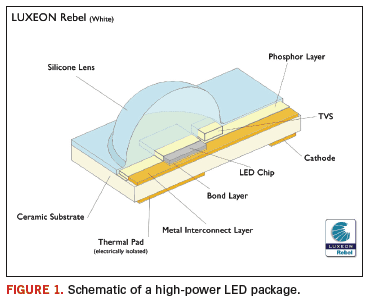
Rudi Hechfellner, applications manager for Philips Lumileds Lighting, San Jose, California says that thermal management is by far the most critical aspect of LED system design. Hechfellner pointed out that even the most thermally efficient LED devices requires that a cooling system be developed around it. He said that because most traditional lighting methods radiate heat, they do not have that level of thermal issues. Many systems manufacturers have much more experience in the electrical and mechanical than in the thermal aspects of design. “What the engineering community needs is a change of their mindset and think thermal first and electrical later,” Hechfellner said. “Thermal represents 90% of today’s design challenges for LED systems manufacturers while electrical and mechanical together provide only 10%.”
The nature of an LED package is such that even as LEDs increase in efficiency, the challenge of thermal management will not disappear. As light output reduces with temperature, a greater proportion of the electrical power is turned into heat, further increasing the temperature. The light output from an LED reduces as it ages, so its heat output may increase over time, accelerating the rate of degradation. A common cause of lumen depreciation in white LEDs is a yellowing of the phosphor, which may be heat or environmentally induced but does not necessarily mean that the chip is working less efficiently or that there is more heat being generated. Thermal management solutions must become more effective in removing the heat dissipated by an LED over its useful life.
System Level Design Considerations
The design considerations are different for every LED and care must be taken to understand the metrics and performance of the LED being used in the application. The essence of LED system design is transferring the heat efficiently from the LED thermal spreader, slug or wire leads to the ambient surroundings. First of all, a secure and thermally efficient bond must be provided between the slug and the circuit board pad. The thermal connection typically runs through a small thermal via in the PCB to a large copper area on another layer. Heat is typically conducted through this layer to the enclosure or an external heatsink. Understanding these system level thermal management challenges are integral right from the start, in the PCB design phase.
An external heatsink may be required in situations where an exceptionally large amount of heat is dissipated within the enclosure. Copper and aluminum are commonly used materials for LED heat sinks. Optimizing the geometry of the heat sink is a critical concern in many applications, as the heatsink-to-air thermal resistance is often significant. Heat sink performance varies depending upon factors such as the material, number of fins, fin thickness, base thickness, etc. External heatsinks extend the surface area available for heat to transfer to the ambient air. The optimum design depends on the local air flow conditions that are affected by the introduction of the heatsink, increasing the design challenge.
Copper offers superior thermal conductivity, while aluminum is lighter and less expensive. In some cases, PCBs made of materials that improve heat transfer through the board may be used. These boards may be made of ceramic, coated steel, aluminum or some of the newer, thermally enhanced PCB laminate materials.
The most difficult LED applications are those that require an airtight enclosure to protect the LED from its environment. One way to address this challenge is to use an enclosure material having a high thermal conductivity. In other cases, more elaborate measures may be required. One example is an air-to-air heat exchanger design that uses internal fans to circulate hot air over internal fins, which conducts the heat into the walls of the enclosure. External fans are then used to move cool ambient air over fins fitted to the outside of the enclosure and remove the heat. Heat transfer is then via a series of convection and conduction steps.
Obviously, there are a large number of design variables that need to be considered when designing LED systems. Optimizing the thermal design is critical for a number of reasons. The DoE’s fact sheet on thermal management notes that excess heat affects both short-term and long-term LED performance. The reversible short-term effects are color shift and reduced light output. Minimizing color shift is critical for back lighting in emerging applications such as LCD TVs where increasing the LED density improves the color variation in the image but makes the cooling more challenging.
Increased junction temperature can severely affect lifetime and reliability performance of a power LED. For example, all other things being equal, a 10 degree change in junction temperature has a dramatic effect on lifetime and reliability as shown in Figure 2. Optimizing the thermal design may also have a major impact on product cost. For example, the effectiveness of the thermal design may determine whether or not it is necessary to use a heatsink, a decision that will substantially affect the overall cost. System co-design that brings the PCB into the thermal equation early in the design process can help off-set these costs by integrating novel cooling solutions at the circuit board level.
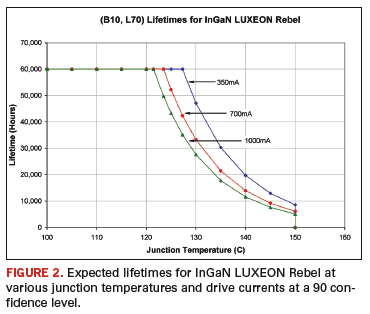
Role of Simulation
Most electronics and original equipment manufacturers (OEMs) and component suppliers have long accepted the need to identify and resolve thermal issues early in the design process. Many have adopted software that performs component- and system-level analysis to address thermal management prior to physical testing, with the goal of avoiding additional design iterations. However, manufacturers of LED systems frequently design systems built around other lighting technologies that do not provide the same thermal management challenges. These companies may not have the required knowledge and expertise to use the powerful and sophisticated computational fluid dynamics (CFD) software used by semiconductor device manufacturers, printed circuit board designers and large electronics OEMs.
The CFD codes of a decade ago and even many used today require the user to have a deep understanding of the computational aspects of fluid dynamics in order to obtain accurate results. For example, users need to know how to translate their computer aided design model into the CFD environment, then “reverse” the model so that empty flow space (rather than the solid product) is modeled, to create an overall mesh with the right properties, determine boundary conditions, select the right physical models, tweak solver settings to ensure convergence, as well as other tasks. Previous generations of CFD software also required a substantial amount of tuning and tweaking, such as manually modifying cells to improve the mesh quality or adjusting solver controls, or relaxation factors, in an effort to get the software to converge to a solution.
But in the last few years a new generation of CFD software has been introduced that addresses the major reasons for its relative lack of use. The new software uses native 3-D CAD data, automatic detection and gridding of the flow space, and manages flow parameters as object-based features, eliminating the need for engineers to understand the computational part of CFD, allowing them to focus on the fluid dynamics of the product that is their responsibility to understand and master. The newest generation of CFD software contains sophisticated automatic control functions that ensure convergence in almost every application without the need for manual tuning.
This new generation of software is well suited to the thermal design of LED systems. The skills required to operate the CFD software are simply a knowledge of the CAD system and the physics of the product, both of which the vast majority of design engineers already possess. The ability to utilize the native 3-D CAD saves time and makes it possible to capture the full geometric complexity of LED systems. The new generation of software also covers all of the possible thermal transfer mechanisms so it can be relied upon for accurate analysis. By automating the steps required in creating a CFD model, the new generation of CFD software makes it possible for LED systems designers to evaluate a large number of design alternatives very quickly.
The lamp shown in Figures 3, 4 and 5 uses six high power LEDs with a built-in power supply that dissipates heat. Since no fans were used, design engineers could only count on conduction, natural convection and radiation to remove the heat. Using a CFD software package embedded in their CAD system, Voxdale engineers defined all the materials and their characteristics, the heat dissipation for LEDs and power supply, gravity direction for convection, etc. After automatic meshing and solving, the results were visualized on the native CAD geometry as shown in the figures.

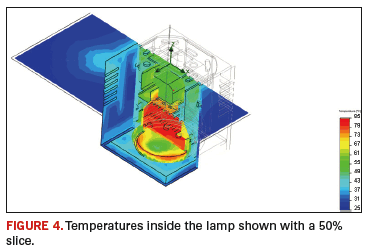
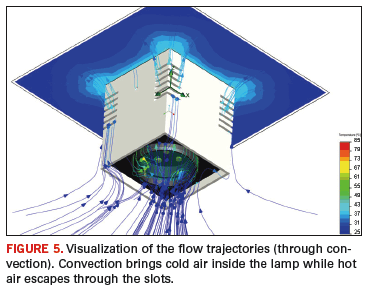
Physical Testing
Physical testing is too costly and time consuming an approach to use to investigate speculative design changes, but is highly effective for both validating the final design and in investigating manufacturing issues. Physical testing can confirm the material property values used in the simulation check bond line thickness, and identify problems such as voids in the die attach.
The leading approach takes advantage of the fact that the temperature is proportional to the forward voltage drop of a specific device. After determining the forward voltage drop at a specific measurement current, a large current is applied to heat the LED. Then this current is turned off while another much smaller test current is applied to make the measurement. The test current used to characterize the device and the forward voltage have to be identical. The forward voltage is measured very quickly before the junction has the chance to cool down. The ability to monitor the temperature change with respect to time can provide detailed information on how heat flows through each layer in the path from the junction outwards. This allows direct measurement of the key thermal resistances in the heat flow path, such as the die attach resistance.
Sophisticated measurement hardware that can measure the temperature change of the device within a few microseconds of being powered off is required, due to the LED’s fast thermal response. This type of thermal transient measurements can be used to generate highly accurate “structure functions” which provide detailed internal information for power-LED packages, revealing die-attach failures and other structural integrity problems.
Conclusions
LED technology offers enormous potential to save energy and enhance lighting quality and reliability. Thermal management is critical in LED design in order to meet performance, service life and cost requirements. Systems designers have a wide range of options to consider in meeting thermal challenges. The latest generation of CAD-embedded thermal and fluid simulation software enables design engineers to diagnose thermal problems, evaluate alternative designs, and iterate rapidly to an optimal solution. The final design can be qualified with measurements at the prototyping stage to ensure manufactured tolerances (e.g., interface thicknesses) meet the thermal design requirements and to identify any manufacturing problems. The knowledge gained can be used to improve future design simulations. PCD&F
REFERENCES
1. Rebello, Jagdish, iSuppli – “The Solid State Lighting Industry: At a Critical Crossroad,” September, 2006.
2. U.S. Department of Energy, Energy Efficency and Renewable Energy, Bulletin PNNL-SA-51901, “Thermal Management of White LEDs,” February 2007.
3. Philips White Paper, “Understanding Power LED Lifetime Analysis.”
Dr. John Parry is the research manager at at Flomerics, and can be reached at This email address is being protected from spambots. You need JavaScript enabled to view it..



















